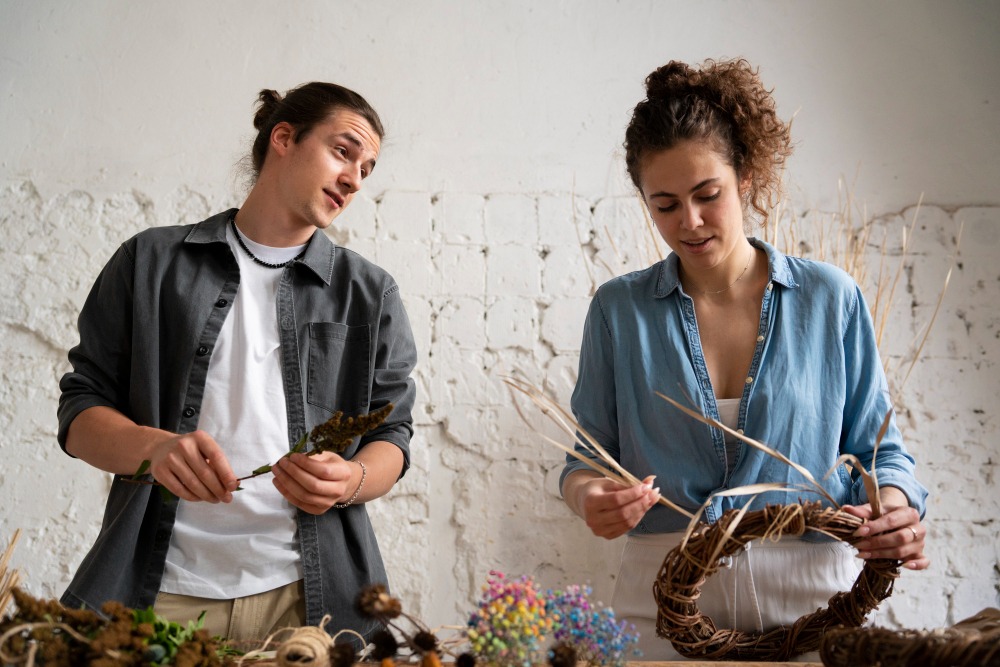As climate change concerns grow worldwide, the art industry has witnessed a significant shift towards sustainable practices in 2024. Eco-friendly art is not just a trend; it’s a movement redefining how artists create, consumers buy, and organizations promote art. The concept of sustainable art revolves around reducing environmental impact through conscious choices, from material selection to energy-efficient production methods. In this blog, we’ll dive into the rise of sustainable art, the best eco-friendly art practices, and why sustainable art is more important than ever.
What is Sustainable Art?
Sustainable art refers to art that minimizes environmental harm by using eco-conscious materials, techniques, and practices. The concept goes beyond the traditional idea of creating “green” art; it involves every stage of the creative process, from sourcing materials to disposal or recycling after the piece is no longer needed. Sustainable art challenges artists to think about their ecological footprint while still producing meaningful, impactful work.
Importance of Sustainable Art
- Combats environmental degradation.
- Reduces reliance on non-renewable resources.
- Promotes awareness of climate issues.
- Encourages innovation in eco-friendly techniques.
Key Components of Eco-Friendly Art Practices
Sustainable art is built on the foundation of several eco-friendly principles. Here’s an overview of the critical components that make an art practice sustainable:
- Sustainable Materials: Using biodegradable, recycled, or upcycled materials to reduce environmental waste.
- Low-Toxicity Supplies: Minimizing toxic chemicals in paints, glues, and finishes.
- Energy Conservation: Opting for renewable energy sources or energy-efficient methods.
- Waste Reduction: Repurposing unused materials and minimizing waste through careful planning.
- Mindful Consumption: Avoiding single-use supplies and sourcing materials responsibly.
Sustainable Art Trends in 2024
In 2024, sustainable art has taken new forms, driven by advancements in technology, growing consumer awareness, and a rising demand for eco-friendly products. Here are some key trends that define eco-friendly art practices this year:
- Biodegradable and Recycled Materials: Artists are increasingly using biodegradable materials, such as organic pigments, bamboo, natural fibers, and recycled metals. This shift significantly reduces the need for new resources and the creation of waste. Recycled canvases and paper are also becoming mainstream in sustainable art.
- Digital Art with Minimal Carbon Footprint: Digital art has risen in popularity due to its low environmental impact. Unlike traditional art forms that require physical materials and space, digital art minimizes the use of resources. With the rise of digital marketplaces, artists can create and share work virtually, lowering the carbon footprint associated with shipping and storing physical art.
- Natural and Eco-Friendly Pigments: The art industry has seen a surge in artists choosing natural pigments over synthetic colors. These pigments, sourced from plants, minerals, and other organic materials, offer unique textures and tones, creating a more organic aesthetic in art.
- Sculptures from Upcycled Materials: Many artists create sculptures from recycled or upcycled materials, such as scrap metal, glass, and reclaimed wood. Upcycled art not only reduces waste but also adds a unique character to the artwork, embodying the concept of giving new life to old items.
- Zero-Waste Art Studios: Artists are increasingly adopting zero-waste principles in their studios. By minimizing waste and reusing materials, these studios reduce the environmental impact of the art-making process. Artists often repurpose or recycle everything they use, ensuring no material goes to waste.
Techniques and Practices for Creating Sustainable Art
Creating sustainable art requires a thoughtful approach. Below are some actionable techniques and practices that artists can incorporate into their work:
- Use Recycled and Upcycled Materials
One of the simplest ways to reduce waste in art is to use recycled or upcycled materials. Artists can source materials from second-hand stores, salvage yards, or even nature. Using upcycled items not only saves resources but also adds unique textures and elements to the artwork.
- Opt for Natural Dyes and Pigments
Natural dyes made from plants, fruits, and minerals provide vibrant colors without the harmful chemicals in synthetic dyes. These pigments are non-toxic, biodegradable, and safe for both artists and the environment. Popular natural pigments include indigo, turmeric, and beetroot.
- Minimize Water and Chemical Usage
Water conservation is critical in sustainable art practices. Artists can minimize water usage by using water-based paints, avoiding excessive washing of brushes, and recycling rinse water. Additionally, choosing non-toxic chemicals in paints, glues, and finishes can drastically reduce the harmful impact of art materials on the environment.
- Solar-Powered Studios and Equipment
With the increasing accessibility of renewable energy, many artists have started using solar-powered equipment and lighting in their studios. Solar energy is a sustainable option that reduces dependency on non-renewable resources and lowers electricity bills.
- Create Art with End-of-Life in Mind
Sustainable art should consider its entire lifecycle, including its end-of-life. Artists can design works that are easy to dismantle, recycle, or biodegrade, ensuring minimal waste even after the art has fulfilled its purpose.
The Impact of Sustainable Art on the Environment and Society
Sustainable art contributes to environmental preservation, raises awareness of ecological issues, and encourages responsible consumption among buyers. Eco-friendly art practices have a ripple effect, inspiring individuals, businesses, and governments to adopt more sustainable habits.
Environmental Impact:
- Reduces landfill waste and pollution.
- Decreases carbon emissions associated with the production and shipping of materials.
- Preserves natural resources by using biodegradable and recycled materials.
Social Impact:
- Raises awareness of climate change and environmental issues through art.
- Inspires artists, collectors, and viewers to consider sustainability in their lives.
- Supports a growing market for eco-friendly and socially responsible products.
How to Promote Sustainable Art Practices
While sustainable art is gaining popularity, there’s still work to be done to promote and normalize eco-friendly practices in the art world. Here are some effective ways to encourage sustainable art:
- Educate and Inform the Public: Use social media, blogs, and exhibitions to spread awareness of sustainable art. Artists can share their sustainable practices, inspiring others to adopt eco-friendly methods.
- Collaborate with Eco-Conscious Organizations: Partnering with environmental organizations can provide valuable resources, knowledge, and support to artists interested in sustainability.
- Offer Sustainable Art Workshops: Artists can host workshops on eco-friendly techniques, such as natural dyeing, upcycling, and zero-waste practices, to educate and inspire others.
- Encourage Galleries to Feature Sustainable Art: Galleries play a crucial role in setting trends in the art world. By curating exhibitions focused on sustainable art, galleries can help promote eco-conscious practices among artists and collectors.
The Future of Sustainable Art: What’s Next?
In the coming years, sustainable art is expected to become more mainstream, with continued innovation in eco-friendly materials and methods. Here are a few trends likely to shape the future of sustainable art:
- Technological Advancements in Eco-Materials: The development of eco-friendly, durable materials like bio-plastics and plant-based resins will provide artists with more sustainable options for their creations.
- Expansion of Digital and Virtual Art Spaces: With the growing popularity of digital art, virtual galleries, and NFT marketplaces, artists can showcase their work without the environmental impact associated with traditional exhibitions.
- Greater Accountability and Transparency: Consumers and collectors are becoming more conscious of sustainability, demanding greater transparency from artists and galleries. Labels and certifications for eco-friendly art practices may become standard.
- Cross-Industry Collaborations: Artists may increasingly collaborate with scientists, environmentalists, and technologists to explore innovative ways of incorporating sustainability into their art.
How to Support Sustainable Art as a Consumer
For art enthusiasts and collectors, supporting sustainable art is a powerful way to promote environmental consciousness. Here are some ways to do so:
- Buy from Eco-Friendly Artists and Galleries: Seek out artists and galleries that prioritize sustainable practices, use recycled materials, and minimize waste in their work.
- Opt for Digital Art: Collecting digital art has a significantly lower carbon footprint compared to physical artwork. Digital art marketplaces make it easier to discover and support artists who prioritize sustainability.
- Attend Sustainable Art Exhibitions: Many art exhibitions and fairs are now dedicated to eco-friendly practices. Attending these events can provide insights into sustainable art practices and introduce you to like-minded artists.
- Ask About the Art’s Lifecycle: Don’t be afraid to ask questions about how the artwork was made, what materials were used, and what will happen to it at the end of its life.
Conclusion
The rise of sustainable art in 2024 represents a positive shift toward a more eco-conscious and socially responsible art industry. By adopting eco-friendly practices, artists can reduce their environmental footprint, create meaningful work, and inspire others to make sustainable choices. As the movement grows, we can expect to see even more innovative, impactful, and eco-friendly art shaping the future of creativity and culture.


